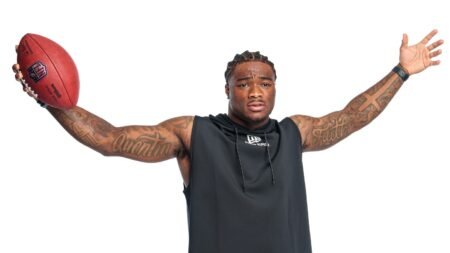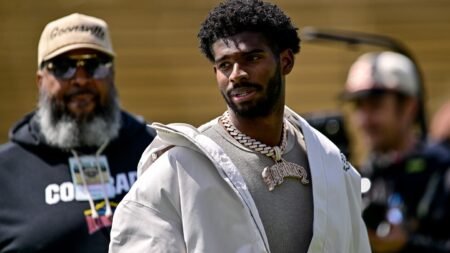The second day of the 2025 NFL Draft just wrapped and it’s already time to talk about the fantasy football implications of every pick. These are my instant reactions to every skill position selection of the second and third rounds.
Texans double up on Iowa State receivers
The Texans entered night one of the draft with glaring needs at tackle and wide receiver. Instead of forcing the issue, Houston made a prudent move and traded back with the Giants. They moved to pick No. 34, netting a pair of third-round selections for their efforts. GM Nick Caserio flipped the script on the second day of the draft, aggressively pursuing the team’s needs. They kicked off the proceedings with Iowa State’s big-bodied Jayden Higgins. The 6’4/214 wideout is a boundary receiver who averaged 2.8 yards per route run in two seasons as a Cyclone. He profiles similarly to Nico Collins, making it an awkward fit out of the gate. However, as my colleague Denny Carter pointed out, “He’s a good fit because he’s good at football.” Truer words have never been spoken about a wide receiver.
Not done stacking up receiver talent, the Texans double-dipped on Iowa State wideouts with slot aficionado Jaylin Noel. Higgins commanded targets on the outside, clearing space for Noel to dominate intermediate work. He racked up 1,194 yards and eight scores on 80 receptions in his final season. Having run 75 percent of his career routes from the slot, Noel makes more sense as a natural complement to Collins, but it’s anyone’s guess as to how the targets will shake out between the Iowa State duo and recently-acquired Christian Kirk.
Browns draft bruising Buckeye Quinshon Judkins
Cleveland entered the draft with Jerome Ford as the only “proven” back on their roster, and he’s only shown replacement-level play in the pros. In need of a back who can shoulder the load, the Browns stayed in state with Ohio State’s power back. Judkins handled the dirty work for the Buckeyes in 2024, taking on 194 carries for 1,064 yards and 14 scores, leaving the explosive touches to fellow second-round pick TreVeyon Henderson. Judkins was previously a three-down workhorse at Ole Miss, amassing 545 carries and 37 receptions in two seasons as the Rebels’ starter. He isn’t the flashiest back in the class, but Judkins is a highly drafted runner with a history of elite volume and an unobstructed path to carries. That’s a recipe for success in dynasty and redraft leagues.
Pats give Drake Maye a weapon in TreVeyon Henderson
The other Ohio State back received plenty of first-round buzz heading into the draft, but the hype fizzled out, sending him to pick No. 38, two spots after Judkins. Unlike his teammate, Henderson does not find himself with a clear path to RB1 status on his team. Rhamondre Stevenson recently signed a four-year, $36 million extension in New England, likely locking him in for early down work even with Henderson in the fold. The good news for Henderson is that he was built to make a lot out of a little. Henderson averaged 7.1 YPC and scored 10 touchdowns on 144 attempts as a senior. He also totaled 284 yards and an extra touchdown through the air. We’re stuck with committee work for the explosive Buckeye early in his career, making him a frustrating fantasy from the jump. Still, it would be short-sighted to say he doesn’t have a high ceiling late in the 2025 season.
Tight ends go early and often
Tight end is a position that doesn’t typically produce year one breakouts, with a few exceptions breaking the mold in recent seasons. This class doesn’t have a Brock Bowers or Sam LaPorta, so I’ll be brief (relatively) with the entire crop of Day Two picks here.
LSU’s Mason Taylor emerges as the big winner of the night. Going at No. 42 overall pick to the Jets, Stone Smartt is his biggest competition for reps as a rookie. Taylor was never the focal point of LSU’s passing attack, but he topped 400 yards as a true freshman and peaked at 55 catches for 546 yards and two scores in his third and final season. At 6’5/251, Taylor also looks the part of a starting tight end in the pros. There should be some TE2 juice here if Taylor wins the starting gig in training camp.
Oregon tight end Terrance Ferguson was the surprise draft capital earner of Day Two, being taken at No. 46 by the Rams. Ferguson was an uber-athlete coming out of Oregon with a 9.34 RAS at a position where athleticism is king.
His production was just solid. He went for 591 yards in 2024, but nearly two-thirds of that came on play-action throws. Ferguson could be an interesting pass-catching specialist as a rookie, but Sean McVay’s love of 11-personnel will make snaps hard to come by behind Tyler Higbee.
Miami tight end Eliah Arroyo, taken at 50th overall, is currently parked behind Noah Fant. Arroyo was a one-year producer in college, hitting 590 yards during Cam Ward’s explosive 2024 campaign. He didn’t account for much of the team’s passing production but was an effective YAC producer, averaging 8.9 yards after the catch while feasting on zone coverage. Barring a Fant trade, Arroyo is just a long-term stash.
The absurdly productive Harold Fannin Jr. was the final tight end selected on Day Two of the draft. Cleveland pulled the trigger with the 67th pick. Fannin holds the record for the most yards (1,555) and catches (117) by a tight end in a single season in FBS history. His slightly undersized frame and previous rushing usage gave H-back vibes before the draft. A team that already has David Njoku locked in as the starter being the one to draft Fannin makes the H-back allegations even more likely to stick, at least in 2025. Njoku is a free agent after the upcoming season, giving Fannin truthers some hope for a year two breakout.
Luther Burden’s slide ends at No. 39 with Chicago
A first-round hopeful, Burden didn’t hear his name called in the first 32 picks and instantly took to social media to document a late-night workout.
He’s posting like an All-Pro wide receiver already. Burden’s sophomore breakout of 1,212 yards and nine scores was built on designed touches. His reliance on being schemed the ball is a red flag to some, but the fact that the Mizzou staff spent every waking hour dreaming up ways to get the ball in Burden’s hands is a bullish signal to others. Offensive guru and new Bears head coach Ben Johnson was extremely creative with his play designs in Detroit. Jameson Williams had a rushing touchdown in back-to-back regular and postseasons. Though Burden will win more on short looks and less on deep shots than Jamo, Johnson’s willingness and ability to get the ball in the hands of his play-makers is a great sign for Burden.
Saints take Derek Carr replacement with Tyler Shough
The Saints were rumored to be the most likely landing spot for seven-year college football veteran Tyler Shough for much of the draft process and made the chalk pick when they took the podium at No. 40. Shough started his career at Oregon as Justin Herbert’s backup, couldn’t stay healthy during three years at Texas Tech, and finally gave us a single complete season at Louisville with 3,195 yards, 23 scores, and six interceptions. At 6’5/219, Shough has prototypical quarterback size and the arm strength to match his build. He protects the ball well and has loads of experience. With Derek Carr’s future in New Orleans somewhere between uncertain and totally over, Shough is shaping up to be an “eat your vegetables” pick in Superflex leagues.
Chargers take efficiency superstar Tre Harris
The Chargers sorted the spreadsheets by yards per route run last year and landed on Ladd McConkey, who turned out to be a smash hit and true No. 1 receiver for Justin Herbert. They ran back that approach this year and drafted the most efficient receiver of all time. Harris averaged 5.1 yards per route run—the best single-season mark (min. 200 routes) in the past 15 years—at Ole Miss in 2024.
He only appeared in eight games and juiced the numbers by crushing some weak opponents early in the season, but Harris made a habit of dusting cornerbacks as an intermediate and deep threat on the outside. He is a phenomenal fit with Herbert’s cannon of an arm and McConkey’s ability to win out of the slot.
Jack Bech lands in Las Vegas
TCU’s Bech was a sleeper of mine before the draft and the Raiders sent him mainstream with pick 58. Bech was initially recruited to LSU and led a team with Malik Nabers, Brian Thomas Jr., Kayshon Boutte, and Tre Palmer in catches (42). He fell out of the mix in Baton Rouge and transferred to TCU. Bech broke out as an outside chain-mover in the Big 12, leveraging his bulky 6’1/214 frame to beat up on Big 12 defenses. Despite his sizable build and ability to win contested looks, Bech plays more like a slot receiver, winning primarily against zone and rarely dropping his catchable passes. He has some Diontae Johnson to his game and could be a target-earner early in his career.
Sean Payton gets his “Joker”
Payton was telling anyone willing to listen about his desire to fill the “Joker” role in his offense this offseason. The job was infamously occupied by Taysom Hill in New Orleans, though dynamic running backs like Alvin Kamara also fit the bill at times. Denver selected UCF running back RJ Harvey with the No. 60 pick in the second round. The former quarterback (read: future “Joker”) switched positions and transferred from Virginia to UCF. Because of this, Harvey was a late bloomer at running back. Despite the late breakout, it was worth the wait when he finally hit. Harvey ran for 1,577 yards and 22 touches at 6.7 YPC in 2024. He also added 267 yards and three scores through the air. Harvey has incredible burst when hitting the hole and a 4.4 Forty gives him an impressive top gear. The burst was also evident in his workout metrics at the combine.
Harvey will be the biggest fantasy riser of the draft at running back, maybe at any position.
The Broncos also added Illinois wideout Pat Bryant. Bryant was a late breakout, reaching 983 yards at 2.8 yards per route run in his final season. His 4.61 Forty is unimpressive for a field-stretcher and NFL.com’s Lance Zierlein graded him as a sixth-round pick. Given Payton’s proclivity for rotating his receivers, Bryant shouldn’t have much of a fantasy impact in 2025.
Sleeper WRs Kyle Williams and Isaac TeSlaa go on Day Two
Two sleepers for very different reasons, Williams had backers in the film community and among the spreadsheet nerds while TeSlaa made his name as a combine warrior. Williams was elite at generating separation on tape and was the rare true freshman breakout, dominating UNLV’s passing attack with 426 yards in a season shortened to six games because of the COVID-19 pandemic. Williams went through plenty of ups and downs over his five-year career but capped it with 1,198 yards and 14 touchdowns at Washington State in 2024. After striking out on Ja’Lynn Polk and Javon Baker, the Pats returned to the wide receiver well with Williams at pick No. 69. His ability to get open downfield should mesh well with Drake Maye’s arm, and there’s nothing standing between Williams and a full complement of routes as a rookie.
TeSlaa has an entirely different profile. He was a dominant Division II wideout at Hillsdale College but couldn’t reproduce his stats after transferring to Arkansas, where he peaked at 545 yards in 2024. TeSlaa put his name on the Day Two periphery with a jaw-dropping combine.
TeSlaa will need time to translate his 99th-percentile athleticism into on-field production, but he could give the Lions a backup plan for Jameson Williams if the two sides can’t figure out an extension ahead of his post-2026 free agency.
Steelers get their Najee Harris replacement
Several teams chose not to interview players they were interested in this year. Despite the trend spreading across the league, Pittsburgh remained possibly the easiest team to read. Their beats universally called their first-round pick of Oregon DT Derrick Harmon and Iowa’s Kaleb Johnson—who the team hosted for a pre-draft visit—was also a popular connection for those close to the organization. Selected with the pick No. 83 in the third round, Johnson (6’1/224) is a massive back for modern standards. He played faster than his 4.57 Forty on tape, breaking 28 carries of 15+ yards in 2024. That was the third-highest mark in the country. Johnson plays like Kenneth Walker—a home run hitter—but does so with a build closer to Najee Harris. He doesn’t bring much to the table as a pass-catcher, leaving some role for Jaylen Warren on third downs. Even as a two-down player, Johnson should rack up rushing volume and chunk gains for Mike Tomlin.
Packers keep adding at wide receiver
The Packers broke their first-round receiver drought of over 20 years with Texas wideout Matthew Golden on night one. They weren’t done giving Jordan Love role-players to sort through and went with TCU’s Savion Williams via pick No. 87. Williams was a true “weapon” in his final season, catching 60 passes with an additional 51 carries for nearly 1,000 yards from scrimmage and a dozen scores. At 6’4/222 with 4.48 wheels, Williams has the physical profile of a special player, but a crowded receiving room and his raw skill set both point toward a 2026 breakout at the earliest.
Run on quarterbacks does not include Shedeur Sanders
In one of the most shocking draft weekend falls in decades, Colorado’s Shedeur Sanders is still waiting to hear his name called only a few months after being a contender for the No. 1 overall pick. Passing on Sanders, Seattle drafted Jalen Milroe and the Browns took a shot on Oregon quarterback Dillon Gabriel. Milroe was an elite rusher at Bama, running for 879 yards and a stunning 20 touchdowns in 2024. He will back up Sam Darnold as a rookie, but the journeyman could be on a shorter leash than expected.
Darnold has no true guaranteed money in his $100-million contract, though he does have injury guarantees and future guarantees that trigger shortly after the Super Bowl next year. If Darnold struggles, the Seahawks could give Milroe a shot late in the season.
At 5’11/205, Gabriel doesn’t have the build of a typical NFL quarterback, and scouts are generally unimpressed with his arm strength. He executed a variety of schemes at a high level in college between his six total seasons at UCF, Oklahoma, and Oregon. He looks like a player Kevin Stefanski could quickly develop into a high-end backup, but his lack of physical traits will limit his starting potential.
Tai Felton closes out Round Three
Minnesota closed out Round three with Maryland’s Tai Felton at 102. Felton broke out in his fourth season as a Terrapin with a 96/1,134/9 receiving line. He operated on the outside but brings a spindly 6’1/183 build to the table. Felton was surprisingly slippery with the ball in his hands. Pro Football Focus credited him with 26 missed tackles forced in 2024. With Justin Jefferson, Jordan Addison, and T.J. Hockenson all vying for targets ahead of Felton, the rookie isn’t on the redraft radar.
Read the full article here














